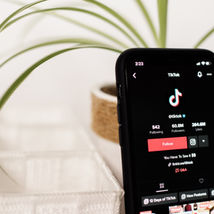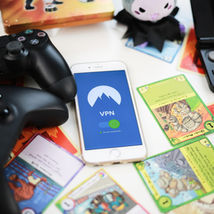TikTok and Online Safety: What Parents Should Know

If you’re the parent of a tween or teen, you’ve undoubtedly heard about the wildly popular social media app TikTok, a video-sharing platform where users can create, watch and share homemade videos shot on their phones. The app has become a hub for many teens who enjoy it as an entertaining, creative outlet, and the hours of fun it can provide draws in users from all over the world.
With users as young as 10 years old participating in the social world of TikTok (all the way up to adults in their 40s and 50s), it’s important for parents to understand the risks associated with the app and the safety implications it could have on their children. All social media platforms come with some level of risk, and the same is true for TikTok. Here are the age restrictions according to TikTok’s official guidelines:
The official age requirement to use TikTok is 13 years old.
Users between the ages of 13 and 15 have their accounts set to private by default. This prohibits them from utilizing the private messaging feature and only allows friends to comment on their videos.
Only users over the age of 16 can record live videos (also known as a “Livestream”) or use the private messaging feature.
Buying, sending, or receiving virtual gifts is restricted to users 18 and older.
Even with these restrictions in place, the potential for online threats still exists. As with any social media platform, the possibility of contact with strangers runs high—given the interactive nature of the TikTok community, this is especially true for TikTok. Other risks include the potential for exposure to elicit content, cyberbullying, and general data privacy concerns.
While these risks certainly shouldn’t be ignored, there are several parental controls that can be activated to help mitigate them. Not only that, but being proactive about discussing internet safety with your children (and as a family) might be one of the best ways you can keep your child safe online. To learn what parental controls are available on TikTok and how to set them up, check out this in-depth guide by Panda Security to walk you through each step. Having a safe experience on TikTok is absolutely possible, as long as you’re equipped with the right tools and knowledge!
What is TikTok?
TikTok is a video-sharing platform where users can watch, create and share videos shot on cell phones. The content found on TikTok runs the gamut from lip-syncing and comedic dancing to educational videos on topics like health or politics. The app provides an interactive world of video-based content where users can connect with each other. But as the TikTok craze continues to spread worldwide, many parents wonder about the safety implications of the app their kids can’t get enough of, particularly if their kids are on the younger side.
TikTok’s official age requirement is 13 years old. Users between the age of 13 and 15 have their account set to private by default, which prohibits them from private messaging and only allows friends to comment on their videos. Only users over the age of 16 can record live videos or use the private messaging feature.

The community associated with the world of TikTok makes it particularly interactive and engaging for users. In addition to creating their own videos, users can follow other creators on the app and engage with their creations through likes, comments, and messages.
Although TikTok has become an entertaining and engaging pastime for many, every social media app comes with some level of risk when it comes to online safety and data privacy. While the majority of content is harmless, there are still some areas of caution to be aware of.
Risks to Consider
If your child uses TikTok and you’re worried about what exactly they’re getting into, you aren’t alone. Educating yourself on the potential safety issues associated with TikTok can help you determine whether or not you’re comfortable with your child using it. Here are the main risks to know about the app.
Exposure to Inappropriate Content
TikTok is split into two main feed sections. The “Following” feed only displays videos created by the users you follow. The “For You” feed curates a stream of suggested videos based on your account activity and the type of content you typically watch.

Things can get problematic when it comes to the For You feed, which could end up surfacing videos containing inappropriate content—whether it’s sexually explicit, profane, or physically dangerous.
While TikTok’s guidelines bar users from sharing illegal or inappropriate content within the app, videos aren’t manually monitored and vetted. Instead, digital algorithms are used to filter out content that violates TikTok’s guidelines. This means that some inappropriate content will inevitably slip through the cracks and make its way onto users’ screens.
Contact With Strangers
With over 1.1 billion people using TikTok, the potential for communicating with strangers runs high. Accounts created by those over the age of 16 are set to public by default, meaning their account activity is visible to anyone. This means they can communicate with anyone and everyone they encounter on the app, including strangers. While accounts made by kids between the ages of 13 and 15 are set to private by default, this restriction can easily be bypassed by entering a false birth date when registering for an account.
Having a public account means more than just having your profile and videos visible to anyone on and off TikTok. It also allows your account to be suggested to other users within the app, enables anyone to comment on your videos, and allows your videos to be downloaded by other users. While these settings can be adjusted to allow for more privacy, the possibility of contact with strangers will always exist.
Cyberbullying
You’re likely aware that social media and cyberbullying go hand in hand, and TikTok is no exception. Whether it’s strangers sharing their harmful opinions or even comments from friends your child knows in real life, TikTok—like every other social media platform—provides a fertile ground for cyberbullying to take root.
A major form of cyberbullying that’s occurred increasingly within TikTok is body shaming. Famous TikTok users have spoken up about their personal experiences being body-shamed in the comment section of their videos and dealing with an endless slew of harmful comments about their body shape and size. This can have far-reaching effects on younger users who are still developing mentally and physically, potentially leading to feelings of worthlessness and humiliation.
Data Privacy
A common concern with any social media platform is the question of how your data is being used. The important thing to realize is that while we tend to think of social media platforms as free, they technically aren’t. They’re paid for by advertisers in exchange for companies like TikTok to show their ads to users on the app.
In order for those ads to be successful and reach their ideal target audience, they need data about those people. That’s how TikTok (and many other social media platforms) makes money: by selling user data to advertisers.

With this in mind, parents should understand what data is being collected on their kids and how it’s being used. TikTok gathers your country location, Internet address, and the type of device you’re using. With your permission, it can also have your exact location, phone contacts, and activity on other social media channels. In addition to your age and phone number, TikTok also has access to any private messages sent within the app.
Safety Measures to Take
If you want to ensure your child uses TikTok safely, there are several steps you can take. TikTok has a variety of privacy control settings that you can set up from your child’s account that can provide a safer experience on the app. Read on for an overview of what safety settings you can manage in TikTok, along with some additional safety precautions you can take to make sure your child is staying safe online.
Use Family Pairing
Family Pairing Mode is a recent addition to the available privacy control measures you can manage on TikTok. Both the parent and child must have their own separate TikTok accounts in order to enable it.
Once enabled, parents can link their account to their child’s and have control of important privacy settings from their own devices. (Previously, parents had to adjust privacy settings within the app on their child’s device.) It’s also password-protected, so unless your child guesses your passcode, they can’t go in and reverse the settings you put in place.

Family Pairing enables parents to manage screen time, direct messaging settings, and the type of content their child can see on the app. To set up Family Pairing, download the TikTok app on your phone and create an account. You’ll also need your child’s phone and their TikTok account logged in and open. Here’s what to do from there:
Tap the three dots next to your user profile, then scroll down to Digital Wellbeing.
Tap Family Pairing and select whether the phone you’re using belongs to you or your child.
A QR code will be displayed on your phone. To link your accounts, your child must scan the QR code.
You can now access and manage the security features of your child’s account.
Here’s some additional information on what exactly you can control with Family Pairing:
Screen Time Management: You can adjust how long your child is allowed to spend on TikTok per day.
Direct Messages: You can restrict who can send messages to your child’s account (Everyone or Friends only), or turn off direct messaging completely. Direct messaging is automatically disabled for users between the ages of 13 and 15.
Restricted Mode: This setting automatically filters out content from your child’s feed that may not be appropriate for young audiences.
Liked Videos: You can adjust who can view the videos your child has liked (Everyone or Friends only).
Comments: You can control who can comment on your child’s videos (Everyone, Friends only or no one).
Suggest Account to Others: Control whether your child’s account can be recommended to others or not.
If your child manages to disable the Family Pairing setting, you will receive a notification on your phone to let you know.
Manage Screen Time
You can set limits on how much time your child spends on TikTok. While you can manage this setting using the Family Pairing feature, you don’t have to set up Family Pairing to adjust it. Keep in mind that without Family Pairing activated, you’ll need to manage this setting from your child’s device. Here’s how to adjust your child’s screen time settings:

From your child’s device, open the TikTok app.
Go to profile, then tap the three dots button to open settings.
Scroll down to Digital Wellbeing.
Select Screen Time Management.
Tap the red button to turn it on.
Choose and confirm a passcode.
To turn Screen Time Management off, simply repeat steps one through four, then choose “Turn off Screen Time Management.”
Direct Messages
You can limit who can send direct messages to your child’s account, or you can turn off direct messaging completely. If you don’t have Family Pairing activated, you can still control this setting—you’ll just have to adjust it directly from your child’s device. Here’s how to manage this setting:
From your child’s device, open the TikTok app.
Go to profile, then tap the three dots button to open settings.
Scroll down to Privacy and Safety.
Select Who can send you messages.
Choose Everyone, Friends, or Off.
Activate Restricted Mode
Restricted Mode allows you to prohibit inappropriate content from displaying on your child’s TikTok feed. While you can manage this setting using the Family Pairing feature described above, you don’t have to set up Family Pairing to adjust it. Keep in mind that without Family Pairing activated, you’ll need to manage this setting from your child’s device. Here’s how to activate Restricted Mode:
From your child’s device, open the TikTok app.
Go to profile, then tap the three dots button to open settings.
Scroll down to Digital Wellbeing.
Select Restricted Mode.
Choose “Turn on Restricted Mode.”
Choose and confirm your passcode.

To turn Restricted Mode off, simply repeat steps one through four, then choose “Turn off Restricted Mode.”
Manage Interactions
There are many additional privacy settings you can adjust to increase your child’s safety while using the app. You’ll have to adjust them from your child’s device, but you can make them passcode-protected to avoid your child interfering with the controls you put in place.
To access additional privacy settings, open TikTok on your child’s device. Go to their profile, then tap the three dots button to open settings. Scroll down to Privacy and Safety, then navigate to the following sections to access more settings:
Under Discoverability:
If you want your child’s account to be private, toggle Private Account to on.
To keep your child’s account from being suggested to other users, toggle Suggest Your Account to Others off.
Under Personalization and Data:
To limit the amount of data TikTok collects from your child’s account, toggle Personalized Ads off.
Under Safety:
Toggle Allow Your Videos to Be Downloaded off.
Turn Who Can Send You Direct Messages to no one.
Turn Who Can React to Your Videos to no one.
Set Who Can View Your Liked Photos to Only me.
Turn Who Can Comment on Your Videos to no one.

Keep in mind you’ll have the option to set these features to Everyone, Friends or no one. Choosing the “no one” setting provides the highest level of privacy and security. If you choose the Friends setting, it’s a good idea to continually monitor who your child adds to their friends' list going forward.
Discuss Internet Safety with Your Kids
For all the ways safety measures you can take to protect your children, there’s always the possibility of something slipping through the cracks. Not only that, but kids may also try to sidestep parents’ digital boundaries and find ways to get around them. That’s why taking time to teach your kids about online safety might be one of the most impactful safety measures you can take as a parent.

By teaching your children why certain boundaries are put into place and helping them understand the severity of certain dangers that lurk online, they’ll be more equipped to manage their own social media experiences.
Kid-Friendly TikTok Alternatives
Even after learning about the safety measures TikTok provides to make sure your child uses the app safely, you might still prefer if they didn’t use it at all. If this is the case, check out these safer alternatives to TikTok that your child can enjoy in place of TikTok.
Dubsmash
Dubsmash is one of the oldest music video apps, but it got overshadowed by the rise of TikTok. However, with over one hundred million downloads worldwide, its popularity is undeniable. Dubsmash allows users to create fun lip-sync videos using thousands of different songs and sounds. It also lets you lip-sync over movie and TV quotes. The online community is similar in nature to TikTok because users post their music videos to their profile and can also view their friends’ videos.
Funimate
Funimate lets users create a variety of videos: slow-motion, compilation videos, looped videos, and a lot more. The app’s large music library allows you to include countless popular songs and sound effects in your videos, and you can also add text and stickers to your videos. Funimate features over twenty video effects to make creations pop and let users showcase their creativity.
Triller
Triller is a safer alternative to TikTok that lets you record videos and share them on other social media accounts like Twitter, Instagram, or Facebook. The simplicity of the app is what attracts most users, including celebrities like Kevin Hart and Selena Gomez. All you have to do is record your footage, and Triller’s auto-editing tool does the rest of the work. Users can edit their videos further with editing tools provided in the app and can use a variety of filters or even draw on the videos for another level of creativity and personalization.
With an overwhelming amount of information available and the ever-changing nature of technology, it can be difficult for parents to keep a pulse on the most important information about the platforms their kids are using. Knowing what privacy settings you can control and setting boundaries with your children is a great way to keep your child protected from online threats, including keeping malware and data breaches at bay.
Ensure your whole family stays protected by maintaining antivirus software on all of your connected devices and decrease the chances of you or your child becoming a victim of cybersecurity threats.




















